Virtual Reality (VR) Training: Benefits & Industry Use Cases

By Shravan Rajpurohit
September 28, 2025

Summary
VR training (Virtual Reality training) uses immersive simulations to help people learn faster, practice safely, and retain knowledge better. This blog explains how VR is transforming industries such as aviation, healthcare, sports, driving, military, and corporate learning. It covers real-world examples like virtual reality surgery training, VR flight simulations, VR therapy, and more. You’ll also discover the key benefits of VR training, the software behind it, and how businesses can get started. Finally, we share why The Intellify is the right partner for building scalable, custom VR training solutions.
One of the most transformative technologies of the decade is virtual reality (VR) training. As businesses around the world work to make learning environments safer, keep students, and make them more efficient, immersive VR training solutions are pushing innovation in aviation, healthcare, sports, manufacturing, and more. As the market for virtual reality training solutions grows, 2025 will be the year when they become widely used.
VR training is no longer just for pilots and surgeons. It’s now being used to teach new employees, train soldiers, get athletes ready for competition, and simulate work situations in a wide range of fields. Not only can people learn by watching, but they can also learn by doing in VR, which keeps them safe, interested, and productive.
What is Virtual Reality Training?
Virtual reality training is a simulated experience delivered through VR headsets that immerses users in a 3D, interactive environment. Unlike traditional eLearning or video-based modules, VR allows for hands-on, experiential learning in a risk-free, repeatable space. Students can interact with a virtual world that looks and feels a lot like real life. You can make these simulations for people to learn on their own, work together, or take tests.
Common components include:
- 360-degree visuals
- Haptic feedback
- Real-time motion tracking
- Scenario-based simulations
- Performance analytics
How VR for Training Works?
VR for training works by creating a simulated environment where learners can interact with scenarios that mimic real-world challenges. Headsets, motion sensors, and haptic devices replicate sight, sound, and touch, allowing learners to perform tasks virtually before attempting them in reality. For example, a pilot can experience turbulence or an emergency landing in a safe VR simulation, while a medical student can practice surgery in a lifelike digital operating room.
Difference Between VR, AR, and MR in Training
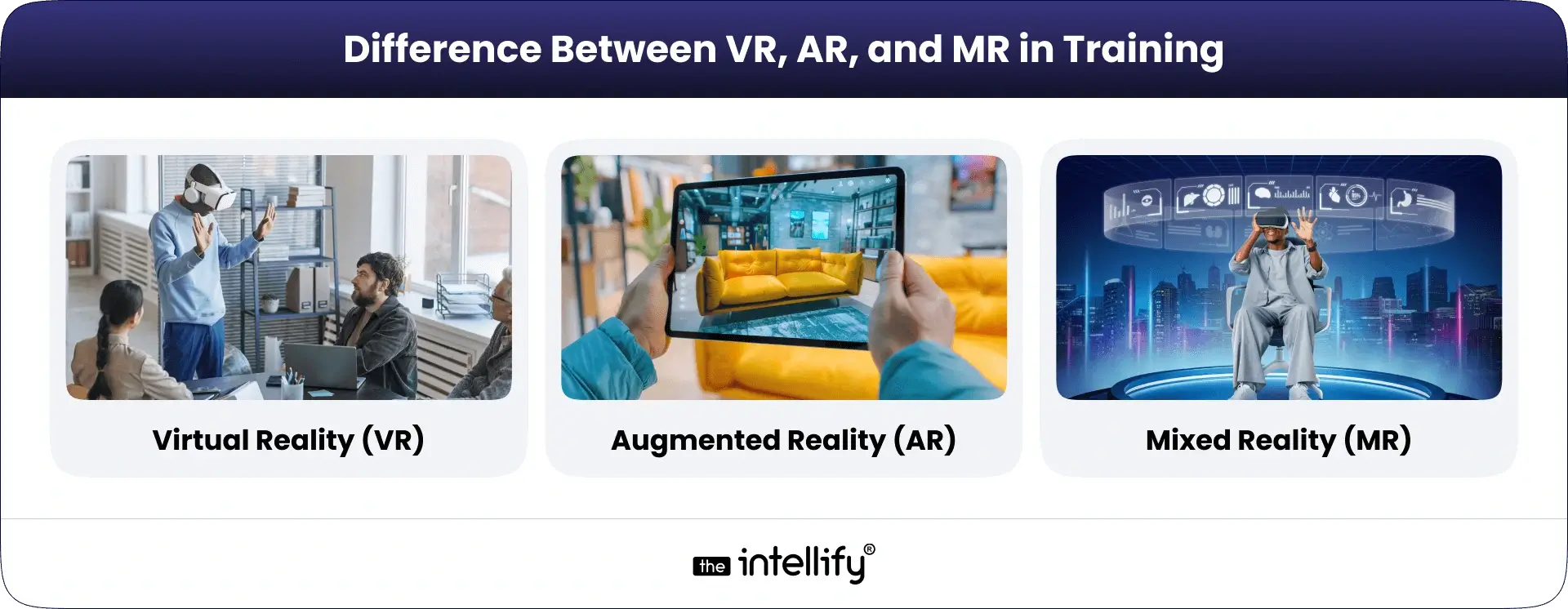
- Virtual Reality (VR): Environments that completely replace the real world. Perfect for training simulations with a lot at stake.
- Augmented Reality (AR): adds digital content to the real world. Best for learning by doing and getting help right away.
- Mixed Reality (MR): Real and digital things that work together in real time. Used for complicated workflows and group training.
Key software platforms that make VR training possible
Unity and Unreal Engine: Commonly used to make immersive, interactive environments and simulations.
Blender: For making 3D objects and assets that are used in simulations.
Custom VR LMS Platforms: These let you add VR content to corporate learning management systems that can track, analyze, and certify users.
SaaS VR Platforms: STRIVR, VirtaMed, and Talespin are examples of SaaS VR platforms that offer plug-and-play virtual reality training software for a range of fields.
Key Benefits of Virtual Reality in Training
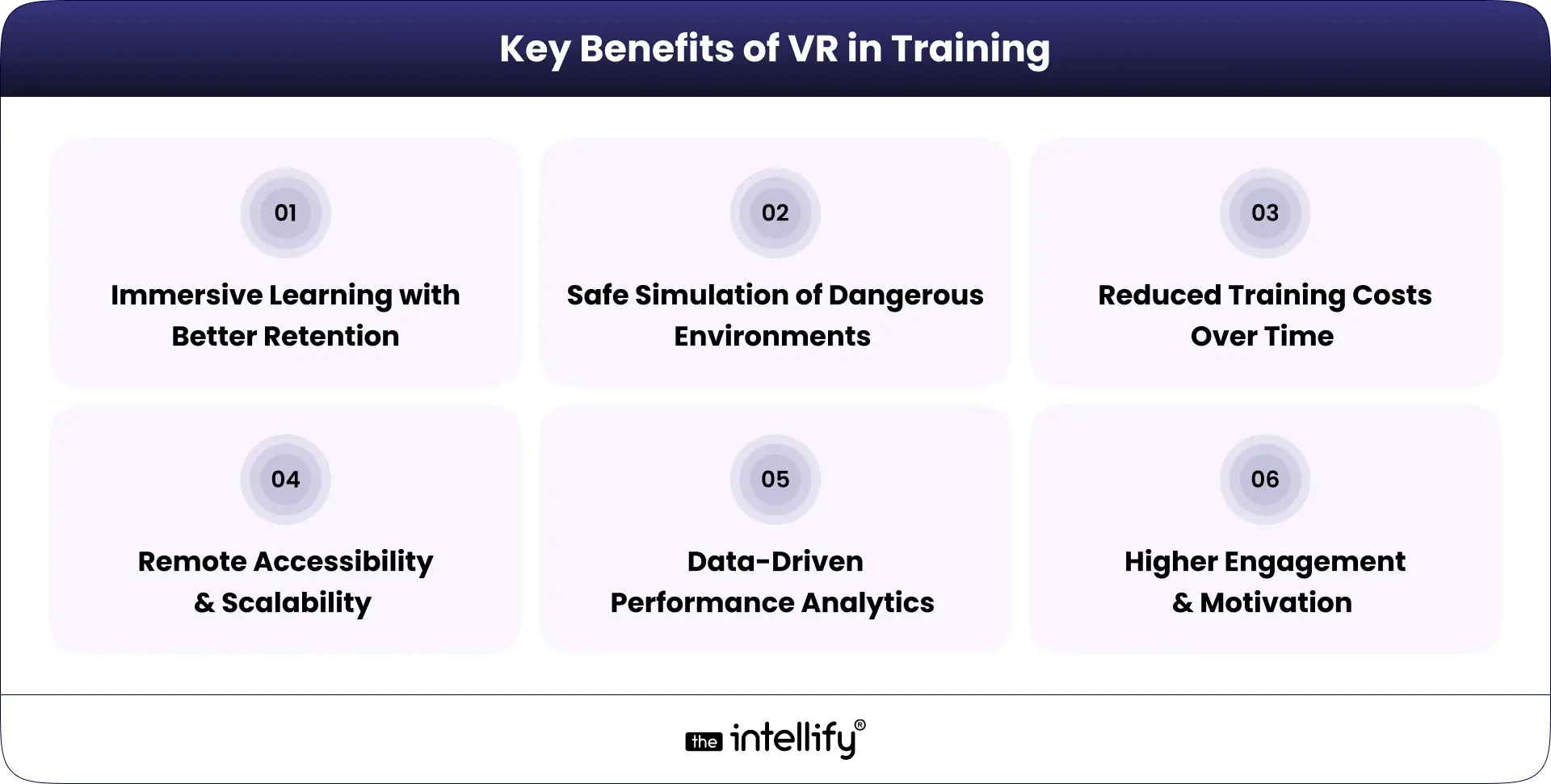
01. Learning that is more immersive and sticks better
Researchers have found that people who learn through VR remember up to 75% of what they do, while people who learn through reading or lectures only remember 10%. There are many benefits to using virtual reality for training, such as learning by doing, remembering what you learned, and getting new employees up to speed faster.
02. Safe Practice in Dangerous Situations
With virtual reality training solutions, you can teach people who work in high-risk fields like aviation, firefighting, surgery, or military combat without putting them in real danger.
03. Training costs go down over time.
Companies save money on travel, equipment, instructors, and facility use in the long run, even though the initial investment may be high.
04. Remote Access and Growth
Cloud-connected VR experiences let learners use virtual reality training software from anywhere, so it can be used by teams all over the world.
05. Data-Driven Analysis of Performance
To make learning paths more personalized, keep an eye on things like completion rate, accuracy, time taken, and how well you make decisions under pressure.
06. Higher engagement & Motivation
Gamified experiences, interactive settings, and stories that draw you in all make people more likely to stick with something and less likely to drop out.
Virtual Reality (VR) Training Across Industries
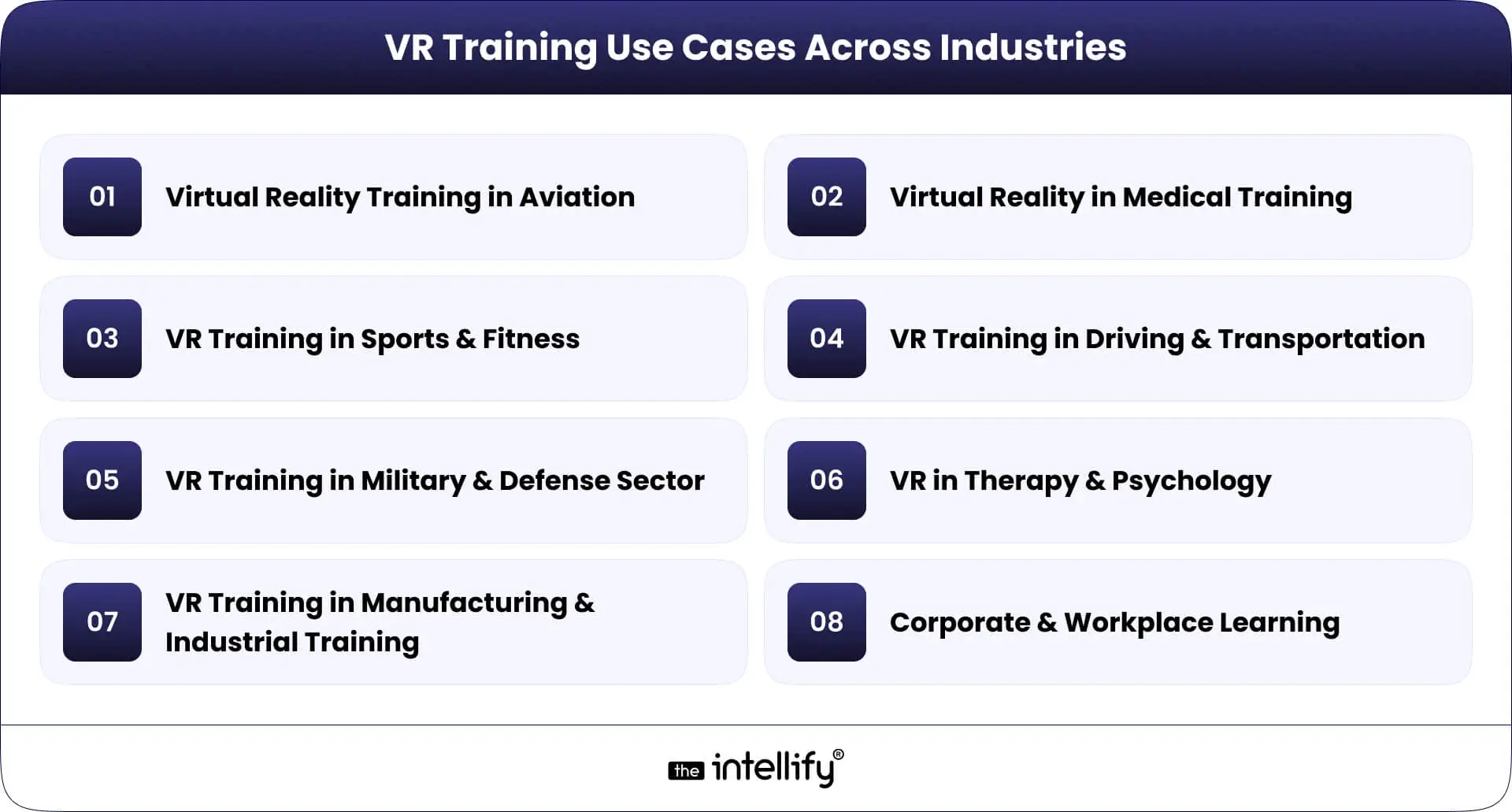
1. Virtual Reality Training in Aviation:
Virtual airline training is changing the way pilots and crew members get ready for problems in the real world. Students learn how to do everything from taking off and landing to responding to emergencies through virtual reality flight training simulations.
For example, Lufthansa uses virtual reality flight training to teach cabin crew how to make emergency landings, get out of a smoke-filled cabin, and do safety drills. This saves time and money.
2. Virtual Reality in Medical Training
Medical students and professionals can practice complicated surgeries in virtual reality. Medical virtual reality training is also used to teach how to diagnose, perform procedures, and talk to patients. Also, VR therapy in mental health helps professionals treat PTSD, anxiety, and phobias in a way that works.
For example, the Cleveland Clinic uses VR surgery simulators to teach heart surgeries, and Limbix and other platforms offer VR therapy training for anxiety disorders.
3. VR Training in Sports and Fitness
Virtual reality baseball training helps players get better at timing their pitches and making accurate swings. Virtual reality football training helps players become more aware of tactics and react faster. VR fitness training apps let you do cardio, endurance, and strength workouts at home or at the gym.
For example, the Dallas Cowboys use STRIVR’s virtual reality football training modules to get better at making decisions, and FitXR offers interactive VR fitness workouts.
4. VR Training in Driving & Transportation
Virtual driving training makes dangerous road conditions seem real and helps learner drivers react faster. Logistics companies use it to teach truck and delivery drivers how to find their way around and stay safe.
Example: UPS uses virtual driving training to help new drivers learn the routes and how to spot hazards before they get behind the wheel.
5. Military and Defense Sector
Virtual reality military training includes things like combat simulations, flying drones, and planning tactical field strategies. Soldiers go through virtual boot camps, and veterans get therapy that focuses on PTSD.
Example: The U.S. military uses virtual reality military training to make conditions like those on the battlefield, in cities, and during mission rehearsals.
6. VR in therapy and psychology
VR therapy training makes it possible to do exposure therapy for PTSD and phobias. Medical virtual reality training helps doctors and other healthcare professionals give cognitive behavioral therapy.
For example: Oxford VR offers mental health clinics immersive VR therapy training programs that help patients get better.
7. VR in Manufacturing & Industrial Training
Safety drills, machine handling, and process walkthroughs are all part of virtual reality training for manufacturing. These simulations lower the number of injuries and make operations run more smoothly.
Example: Ford’s use of VR training modules, for example, has cut down on the time it takes to train new employees and accidents on the assembly line.
8. Corporate & Workplace Learning
Companies use virtual reality training software to teach new employees, improve their soft skills, run sales simulations, and teach DEI.
For example, PwC used VR onboarding and leadership training on a larger scale to get employees ready and interested in their work across all departments.
How to Develop a VR Training Software
Developing a VR training software requires a strategic approach that combines industry expertise, user experience design, and cutting-edge technology. Here’s a step-by-step breakdown:
1. Define Learning Objectives: Clearly outline the skills or knowledge the training should deliver.
2. Design Training Scenarios: Collaborate with SMEs to create realistic environments and workflows.
3. Choose the Right Tools: Use engines like Unity or Unreal, along with VR hardware that fits your budget and audience.
4. Prototype & Test: Build a minimum viable simulation and test with a small group of learners.
5. Deploy & Scale: Integrate with LMS, gather analytics, and refine based on learner performance.
Businesses often choose between off-the-shelf VR training software or custom-built solutions depending on budget, scalability, and complexity.
Challenges in Adopting VR Training
- Cost of making hardware and content: Use cheap VR headsets to make a minimum viable product (MVP) and then grow it based on what people say.
- User Resistance and VR Motion Sickness: Choose content that is ergonomically optimized and offer tutorials to make onboarding easier.
- Integration of Technology: Choose vendors that can connect their APIs to your current LMS or HRMS.
- Measuring ROI and Scalability: Use test scores, performance data, and employee satisfaction metrics to find out how virtual reality training affects people.
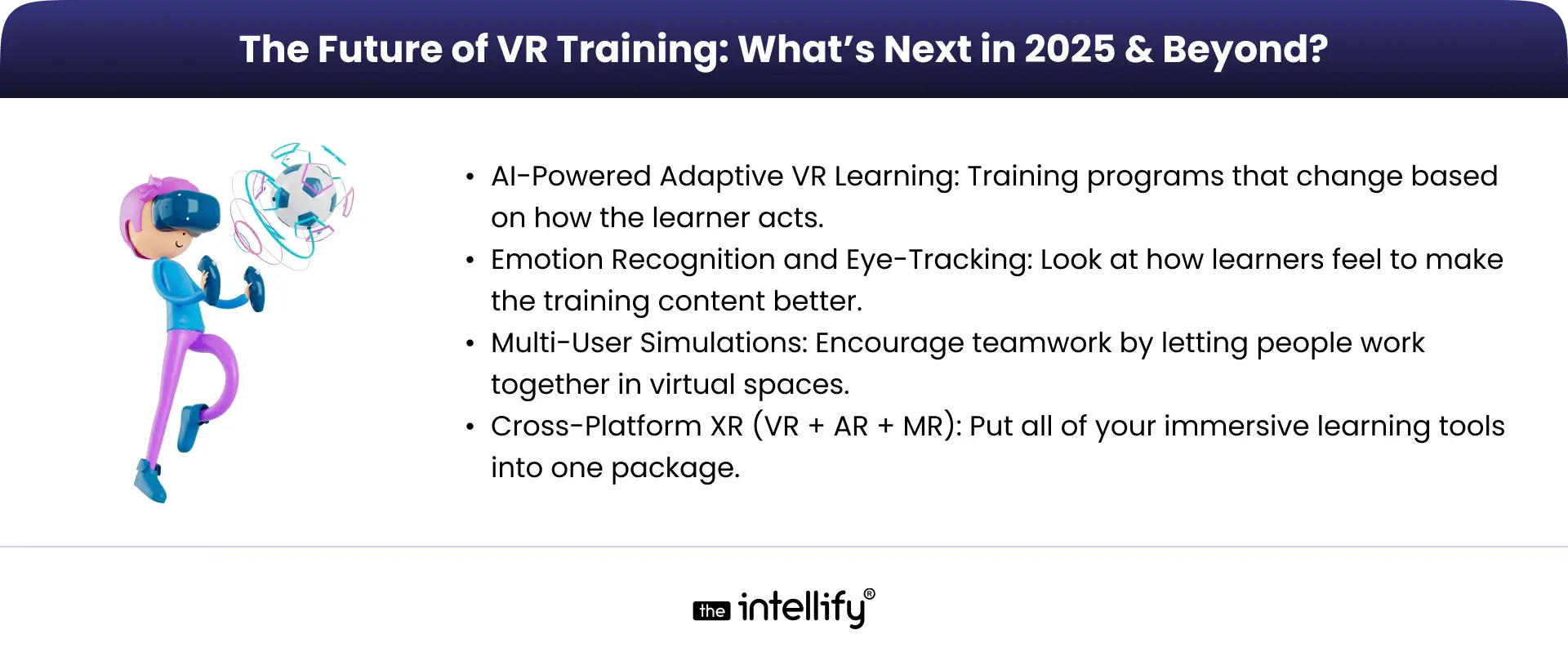
Why Choose The Intellify for VR Training Software Development
At The Intellify, we specialize in building custom VR training solutions tailored to diverse industries like aviation, healthcare, manufacturing, sports, and defense. Here’s why businesses trust us:
- Proven Expertise Across Industries – From virtual reality surgery training to VR flight simulators, we bring cross-domain expertise to deliver practical, high-impact solutions.
- Custom-Built Training Modules – We don’t believe in one-size-fits-all. Every VR training software is designed to meet your unique workflows, compliance needs, and performance goals.
- Cutting-Edge Technology Stack – Our developers leverage Unity, Unreal Engine, AI, and AR/VR hardware integrations to create realistic, interactive environments.
- Scalable & Future-Ready Solutions – We ensure your VR training program evolves with your business whether you need more scenarios, multi-user training, or enterprise integrations.
- Focus on ROI & Engagement – Beyond technology, we prioritize measurable results: faster learning, reduced errors, and higher engagement from your trainees.
Partnering with The Intellify means you get more than just a VR training solution, you get a strategic technology partner committed to transforming the way your workforce learns.
Final Thought
It’s no longer optional to train in virtual reality; it’s necessary. Virtual reality solutions in training & development help businesses provide safe, consistent, and cost-effective learning experiences on a large scale in fields like aviation, healthcare, manufacturing, and sports.
Frequently Asked Questions (FAQs)
Q1. What is VR training, and how is it different from regular training methods?
VR training, or virtual reality training, uses immersive 3D simulations where learners practice in safe, realistic environments. Unlike manuals or lectures, it’s interactive and hands-on, leading to higher retention and confidence. At The Intellify, we build VR training software that makes learning more engaging and effective.
Q2. Which industries can benefit most from virtual reality training?
Many industries benefit, but aviation, healthcare, defense, logistics, manufacturing, sports, and corporate learning see the greatest impact. VR enables pilots to rehearse flights, doctors to practice surgeries, and employees to learn safely without real-world risks. The Intellify delivers VR solutions tailored to each sector’s training needs.
Q3. How safe is VR training, especially for medical or aviation fields?
Virtual reality training is very safe since learners practice in controlled simulations. Surgeons rehearse operations and pilots test emergency landings without danger. Some may face motion sickness if poorly designed, but at The Intellify, we follow best practices to ensure smooth, secure, and realistic VR training.
Q4. How long does it take to build virtual reality training software?
Timelines depend on complexity. A basic VR module can take 6-8 weeks, while advanced, multi-user systems may require several months. The process includes design, development, testing, and integration. At The Intellify, we often launch pilots quickly, then scale them into enterprise-grade VR training software.
Q5. How much does a virtual reality training app cost, and is it cost-effective?
Costs vary depending on content depth, hardware, and user scale. While initial investment is higher than traditional training, VR cuts costs long-term by reducing travel, downtime, and workplace errors. At The Intellify, we design solutions that balance budget and ROI to maximize training efficiency.
Q6. Can virtual reality training be used for soft skills like leadership, communication, or empathy?
Yes. Virtual reality training is increasingly used to build soft skills such as leadership, customer service, teamwork, and empathy. Learners interact in realistic role-play scenarios and receive instant feedback. The Intellify develops VR modules that enhance both technical and behavioral skills for modern workplaces.

Written By, Shravan Rajpurohit
Shravan Rajpurohit is the Co-Founder & CEO of The Intellify, a leading Custom Software Development company that empowers startups, product development teams, and Fortune 500 companies. With over 10 years of experience in marketing, sales, and customer success, Shravan has been driving digital innovation since 2018, leading a team of 50+ creative professionals. His mission is to bridge the gap between business ideas and reality through advanced tech solutions, aiming to make The Intellify a global leader. He focuses on delivering excellence, solving real-world problems, and pushing the limits of digital transformation.
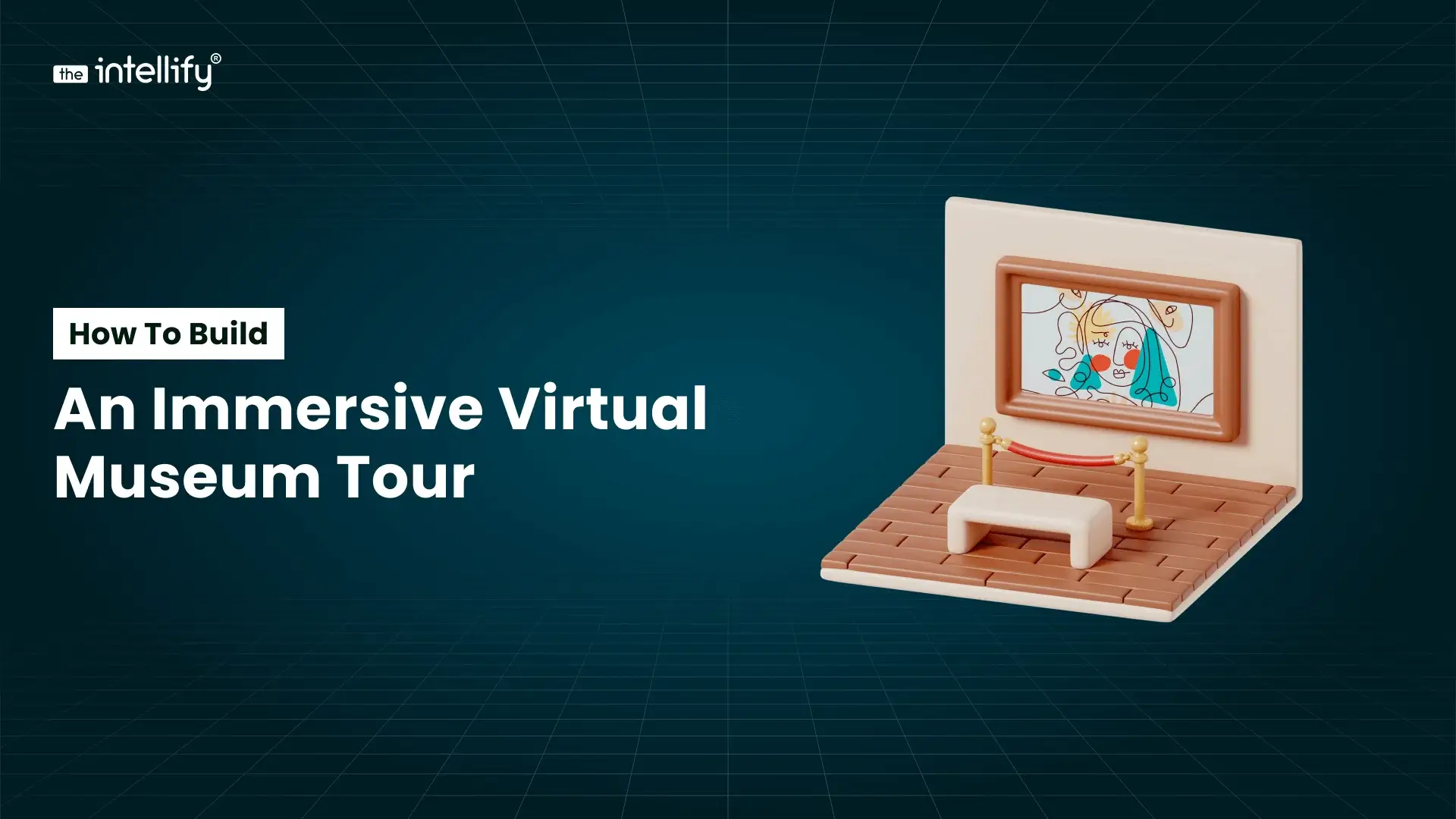

How to Build an Immersive Virtual Museum Tour in 2026
Summary: This blog explains how to create a virtual museum tour in 2026, covering everything from choosing the right tour format to planning layouts, capturing 360° or 3D visuals, adding interactive elements, and integrating AR/VR. It also highlights the key features that make a virtual museum experience successful, the technology stack you’ll need, estimated development […]
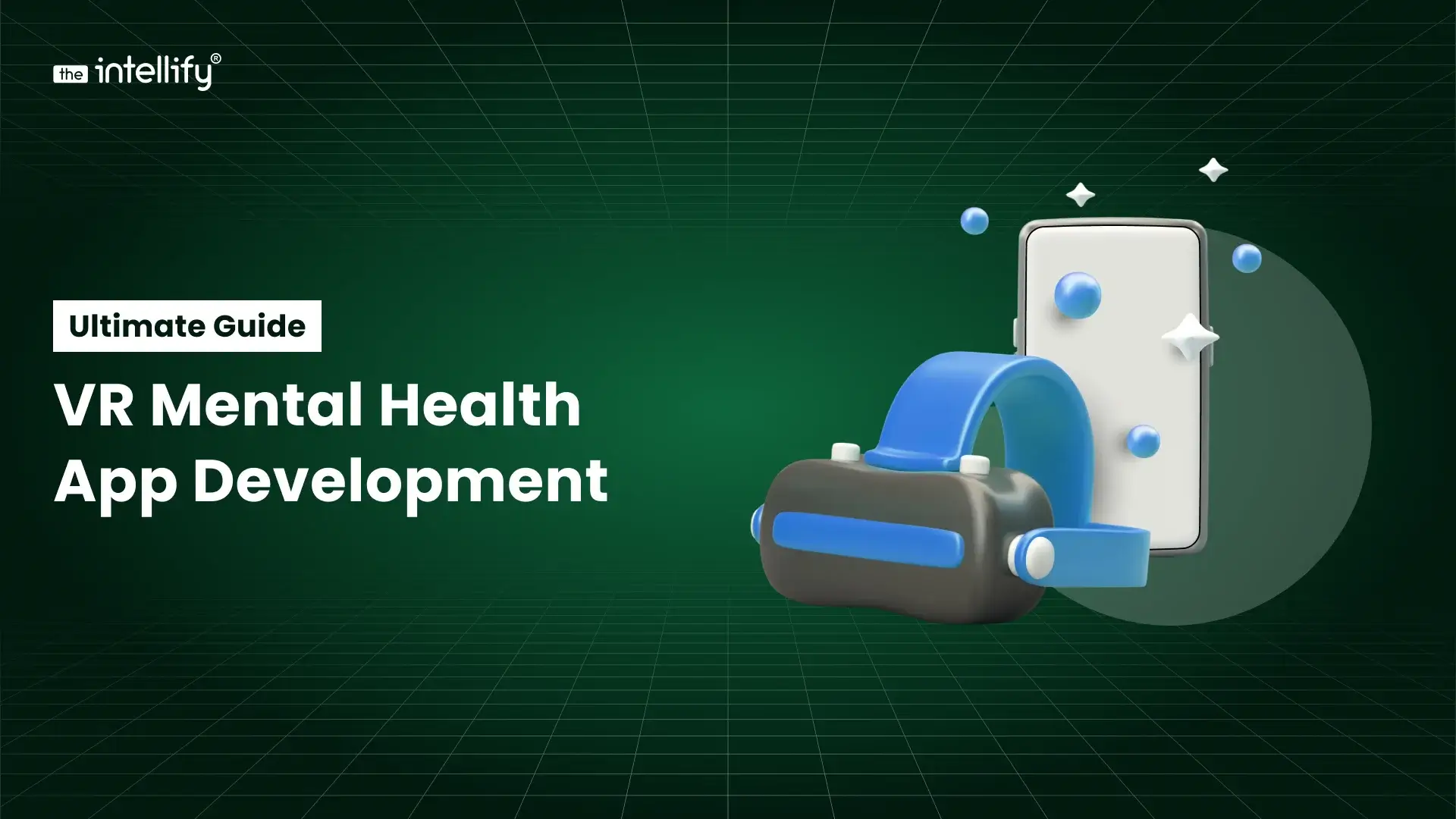

VR Mental Health App Development: Ultimate Guide 2026
Summary: This guide breaks down the essentials of VR mental health app development in a simple, human way. It explains how VR creates safe, immersive spaces for people dealing with anxiety, stress, depression, ADHD, and more. You’ll learn about real use cases, key features, the tech stack, development steps, costs, and what the future of […]
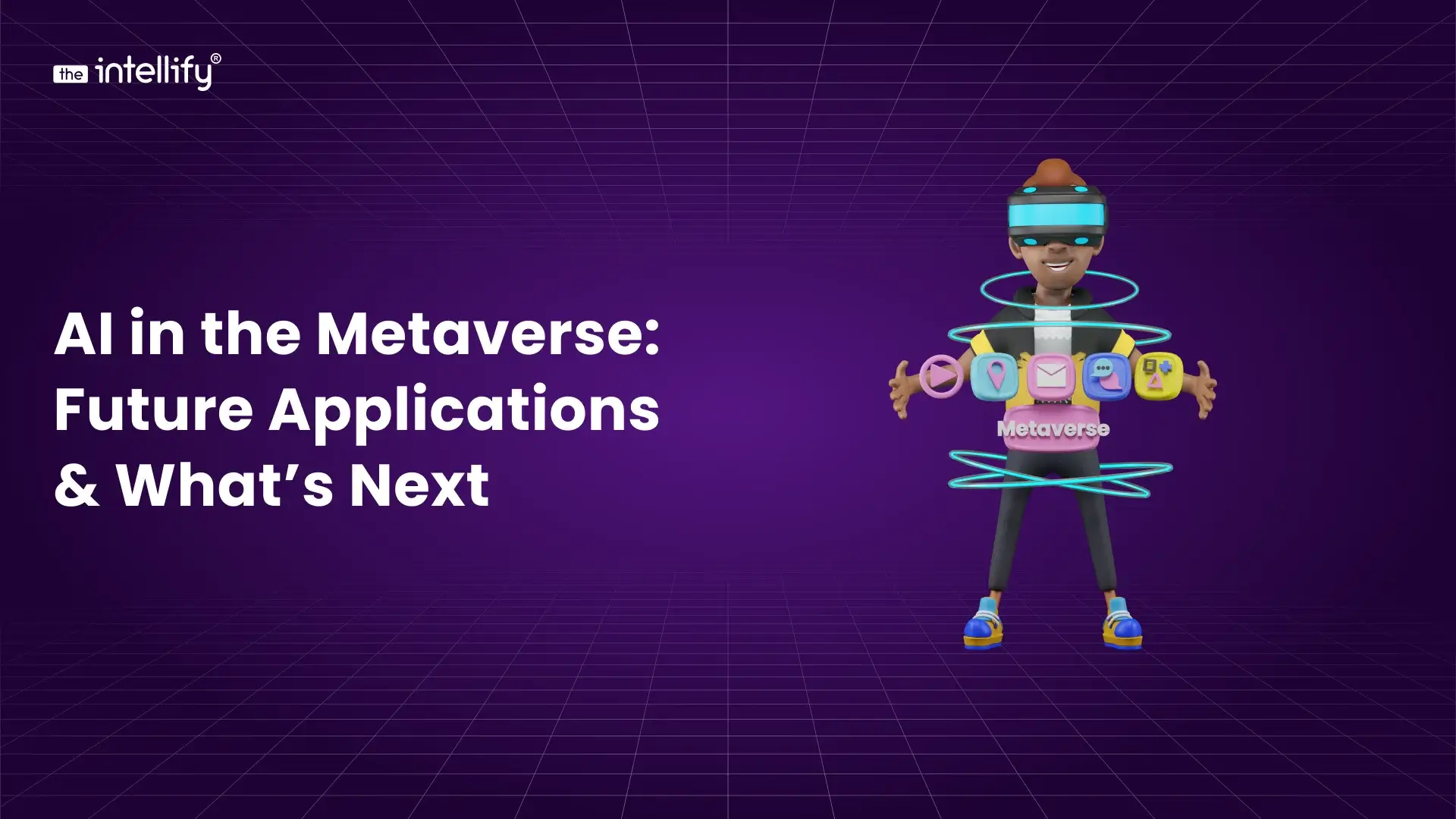

AI in the Metaverse: Future Applications & What’s Next
Summary: This blog explores how AI in the metaverse is slowly reshaping the way we interact with digital spaces. It breaks down how AI personalizes virtual worlds, improves navigation, and makes avatars, environments, and conversations feel more lifelike. You’ll also find practical tips on getting started, plus a look at what the future may hold […]


How to Build an Immersive Virtual Museum Tour in 2026
Summary: This blog explains how to create a virtual museum tour in 2026, covering everything from choosing the right tour format to planning layouts, capturing 360° or 3D visuals, adding interactive elements, and integrating AR/VR. It also highlights the key features that make a virtual museum experience successful, the technology stack you’ll need, estimated development […]


VR Mental Health App Development: Ultimate Guide 2026
Summary: This guide breaks down the essentials of VR mental health app development in a simple, human way. It explains how VR creates safe, immersive spaces for people dealing with anxiety, stress, depression, ADHD, and more. You’ll learn about real use cases, key features, the tech stack, development steps, costs, and what the future of […]


AI in the Metaverse: Future Applications & What’s Next
Summary: This blog explores how AI in the metaverse is slowly reshaping the way we interact with digital spaces. It breaks down how AI personalizes virtual worlds, improves navigation, and makes avatars, environments, and conversations feel more lifelike. You’ll also find practical tips on getting started, plus a look at what the future may hold […]
0
+0
+0
+0
+Committed Delivery Leads To Client Satisfaction
Client Testimonials that keep our expert's spirits highly motivated to deliver extraordinary solutions.


















